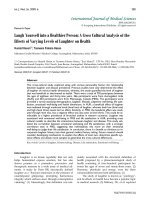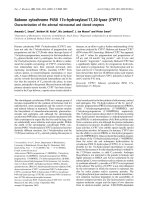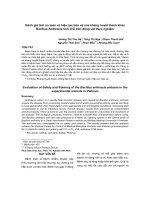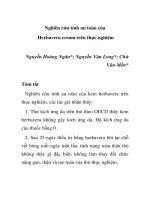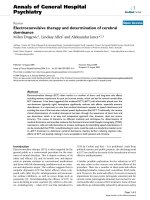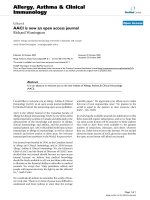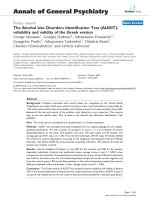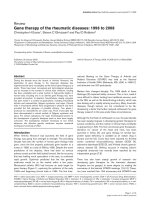Báo cáo y học: "Endoscopic therapy using an endoscopic variceal ligation for minute cancer of the esophagogastric junction complicated with esophageal varices: a case report" ppt
Bạn đang xem bản rút gọn của tài liệu. Xem và tải ngay bản đầy đủ của tài liệu tại đây (970.31 KB, 3 trang )
JOURNAL OF MEDICAL
CASE REPORTS
Akiyama et al. Journal of Medical Case Reports 2010, 4:149
/>Open Access
CASE REPORT
BioMed Central
© 2010 Akiyama et al; licensee BioMed Central Ltd. This is an Open Access article distributed under the terms of the Creative Commons
Attribution License ( which permits unrestricted use, distribution, and reproduction in
any medium, provided the original work is properly cited.
Case report
Endoscopic therapy using an endoscopic variceal
ligation for minute cancer of the esophagogastric
junction complicated with esophageal varices: a
case report
Tomoyuki Akiyama
1
, Yasunobu Abe
1
, Hiroshi Iida
1
, Hiroki Endo
1
, Kunihiro Hosono
1
, Kyoko Yoneda
1
,
Hirokazu Takahashi
1
, Masahiko Inamori*
1
, Akihide Ryo
2
, Shoji Yamanaka
2
, Yoshiaki Inayama
2
and Atsushi Nakajima
1
Abstract
Introduction: Standard endoscopic mucosal resection or endoscopic submucosal dissection is a procedure for
patients with minute cancers, complicated with esophageal varices that puts them at high risk of bleeding.
Case presentation: We present the case of a 77-year-old Japanese man with alcoholic cirrhosis who underwent a
routine endoscopy examination as a screening procedure for esophageal varices and was incidentally diagnosed as
having minute cancer of the esophagogastric junction with esophageal varices. Endoscopic ultrasonography findings
suggested that the minute cancer was a non-invasive carcinoma (carcinoma in situ) and a 2 mm in diameter blood
vessel, feeding the esophageal varices, pierced the lesion. Following the examination, we carried out endoscopic
treatment of the minute cancer and esophageal varices. Endoscopic variceal ligation was performed using a pneumo-
activated device (Sumitomo Bakelite, Tokyo, Japan). Two years after the treatment, during the follow-up endoscopic
examination on the patient, recurrence of carcinoma was not detected endoscopically or histologically.
Conclusion: Endoscopic therapy using an endoscopic variceal ligation device for minute cancer of the
esophagogastric junction, complicated with esophageal varices, may be an acceptable and easily applicable method.
Introduction
Minute cancer is a gastric cancer lesion of less than 5 mm
in its maximum diameter, with tumor cells confined to
the mucosa. Lymph node metastases, meanwhile, are
extremely rare [1,2]. These characteristics of minute can-
cer provide the basis for using endoscopic therapy as a
curative treatment [3]. In this report, we describe endo-
scopic therapy using an endoscopic variceal ligation
(EVL) device for minute cancer complicated with esopha-
geal varices.
Case presentation
A 77-year-old Japanese man with alcoholic cirrhosis had
been undergoing a follow-up laboratory examination
every month for three years. He had been undergoing
imaging studies such as ultrasonography and computed
tomography every month as screening procedures for
hepatocellular carcinoma, and endoscopic examination
every year to monitor esophageal varices. During one
such routine examination, he was diagnosed as having
minute cancer of the esophagogastric junction (EGJ) (Fig-
ure 1) based on the histological examination of the biopsy
specimen (Figure 2) and esophageal varices (Figure 3).
One month later, he was referred to our institution for
endoscopic ultrasonography (EUS) evaluation (Olympus
UM2000, Olympus Optical Company, Tokyo, Japan) and
endoscopic therapy. The ultrasonography findings
showed that the minute cancer was a noninvasive carci-
noma (carcinoma in situ) and a blood vessel, 2 mm in
diameter feeding the esophageal varices, pierced the
lesion (Figure 4).
Following the EUS examination, we carried out endo-
scopic treatment of the minute cancer and esophageal
* Correspondence:
1
Gastroenterology Division, Yokohama City University School of Medicine,
Japan
Full list of author information is available at the end of the article
Akiyama et al. Journal of Medical Case Reports 2010, 4:149
/>Page 2 of 3
varices. The endoscope (GIF-Q200, Olympus Optical
Co., Tokyo, Japan) was preloaded with an overtube, which
was passed into the oropharynx over the already intro-
duced endoscope. The tip of the endoscope was loaded
with a pneumatic EVL device (Sumitomo Bakelite, Tokyo,
Japan). Under full endoscopic suction, the minute cancer
was tightly packed inside the cap of the endoscope, and
the tripwire was pulled, creating an artificial polyp that
included the lesion. After confirmation that the electro-
cautery markings were contained in the ligated band,
resection was not performed for the lesion. EVL was suc-
cessively done for the esophageal varices in three places.
All EVL bands were placed in the esophagus and EGJ.
The iatrogenic ulcers in the esophagus and EGJ resulting
from the EVL were treated with the administration of a
proton pump inhibitor and sodium alginate.
The ulcers were observed endoscopically three months
after the procedure to check for the presence of any resid-
ual lesion or other lesions, and forceps biopsy specimens
were obtained from the site of the resection. A follow-up
examination after two years did not show recurrence of
the disease (Figure 5).
Figure 1 Minute cancer of the esophagogastric junction. White ar-
rows indicate the minute cancer.
Figure 2 Histological examination of the biopsy specimen
showed well-differentiated adenocarcinoma (hematoxylin and
eosin staining, original magnification ×100).
Figure 3 Esophageal varices. (A) The lower esophagus and gastroe-
sophageal junction. (B) The middle esophagus.
Figure 4 Endoscopic ultrasonography with Olympus UM2000
(Olympus Optical Company, Tokyo, Japan), demonstrates that
the minute cancer was noninvasive carcinoma (carcinoma in situ)
and a 2-mm diameter blood vessel (thin white arrows), feeding
the esophageal varices, pierces the lesion. Thick white thick arrows
indicate the minute cancer.
Akiyama et al. Journal of Medical Case Reports 2010, 4:149
/>Page 3 of 3
Discussion
Endoscopic resection has the advantage of providing a
full specimen for histological examination and for the
diagnosis of the extent and infiltration depth of the lesion.
The outcome of endoscopic therapy can therefore be
evaluated on the basis of macroscopic and histologic
findings. However, in our case, our patient with minute
cancer, complicated with esophageal varices, was at a
high bleeding risk because of standard endoscopic
mucosal resection or endoscopic submucosal dissection.
We thus selected endoscopic therapy using EVL, without
mucosal resection, for this lesion. This technique had
several limitations that may need to be considered. First,
large lesions cannot be completely excised with this
method because of the size limitation of the friction-fit
adaptor. In our case, the diameter of the cancer was less
than 10 mm in diameter. Second, because a full specimen
cannot be provided, histological examination and the
diagnosis of the extent and infiltration depth of the lesion
cannot be evaluated.
Conclusion
We believe that because of its technical simplicity and
safety, endoscopic therapy using an EVL device for min-
ute cancer of the EGJ, complicated with esophageal
varices, may be an acceptable and easily applicable
method.
Consent
Written informed consent was obtained from our patient
for publication of this case report and any accompanying
images. A copy of the written consent is available for
review by the Editor-in-Chief of this journal.
Abbreviations
EGJ: esophagogastric junction; EVL: endoscopic variceal ligation; EUS: endo-
scopic ultrasonography.
Competing interests
The authors declare that they have no competing interests.
Authors' contributions
TA, YA, HT and KY analyzed and interpreted our patient data. HI, HE and KH ana-
lyzed endoscopic data. AR, SY and YI performed the histological examination
of the organs. TA, MI and AN were major contributors in writing the manu-
script. All authors read and approved the final manuscript.
Author Details
1
Gastroenterology Division, Yokohama City University School of Medicine,
Japan and
2
Department of Pathology, Yokohama City University Hospital,
Japan
References
1. Iishi H, Tatsuta M, Okuda S: Endoscopic diagnosis of minute gastric
cancer of less than 5 mm in diameter. Cancer 1985, 56:655-659.
2. Oohara T, Aono G, Ukawa S, Takezoe K, Johjima Y, Kurosaka H, Asakura R,
Tohma H: Clinical diagnosis of minute gastric cancer less than 5 mm in
diameter. Cancer 1984, 53:162-165.
3. Tada M, Murakami A, Karita M, Yanai H, Okita K: Endoscopic resection of
early gastric cancer. Endoscopy 1993, 25:445-450.
doi: 10.1186/1752-1947-4-149
Cite this article as: Akiyama et al., Endoscopic therapy using an endoscopic
variceal ligation for minute cancer of the esophagogastric junction compli-
cated with esophageal varices: a case report Journal of Medical Case Reports
2010, 4:149
Received: 25 September 2008 Accepted: 23 May 2010
Published: 23 May 2010
This article is available from: 2010 Akiyama et al; licensee BioMed Central Ltd. This is an Open Access article distributed under the terms of the Creative Commons Attribution License ( which permits unrestricted use, distribution, and reproduction in any medium, provided the original work is properly cited.Journal of Medical Case Repo rts 2010, 4:149
Figure 5 Iatrogenic ulcer has healed with scarring, but without
any residual lesion.
